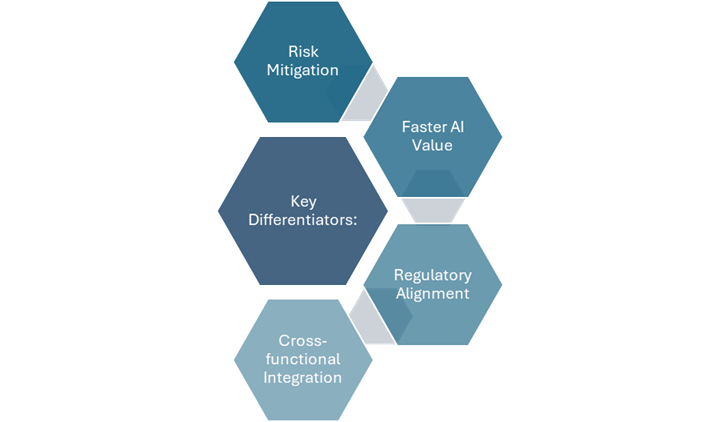
[authors: Daniel Artzer and Dane Cobble]
Enabling Responsible AI Adoption in Heavy Industry
Artificial intelligence (AI) is reshaping heavy industries—including energy, manufacturing, and natural resources—by driving efficiencies, reducing costs, enhancing safety, and enabling smarter regulatory compliance. Successful deployment of AI in complex operating environments hinges critically on effective data governance, analytics, architecture, and integration into broader organizational processes.
There are proven methodologies which can be extended into scalable, enterprise-wide AI solutions. With a structured approach anchored in “People, Process, Data, and Technology,” expert consultants can facilitate the rapid realization of value from AI initiatives, enhancing operational performance and compliance across heavy industries.
This paper will illustrate how a properly structured digital solutions framework seamlessly transitions to support successful enterprise AI implementations.
The Urgency for AI-Driven Digital Transformation in Heavy Industry
Industries today face increasing pressure from evolving regulations, investor expectations, sustainability mandates, and operational complexities, fueling the urgency for digital transformation. Regulatory compliance, traditionally managed through isolated systems and manual processes, now requires robust digital solutions.
Deploying AI solutions shares fundamental parallels with sustainability and environmental, health, and safety (EHS) digital transformations—particularly concerning data governance, quality management, system integration, and organizational readiness. Leveraging proven methodologies from sustainability/EHS implementations, it is possible to effectively addresses these critical areas, allowing enterprises to navigate successful AI transformations rooted in comprehensive data strategies and disciplined frameworks.
Section 1: Solving Environmental, Social, and Governance (ESG) and Compliance Challenges Through Digital Transformation
Organizations in energy and heavy industries routinely confront significant sustainability/EHS challenges, including regulatory compliance complexities, fragmented data ecosystems, poor data quality, and inefficient manual processes. These challenges delay critical decision-making, elevate risks, and inflate operational expenses.
Figure 1 – A digital framework for AI-ready enterprise solutions.
Structured digital transformations following this methodology have consistently delivered measurable outcomes:
- Significant efficiency gains through process automation and streamlined reporting.
- Lowered compliance costs and operational overhead through reduced manual interventions.
- Enhanced risk mitigation, leveraging advanced data analytics and strengthened governance practices.
Section 2: Translating EHS Success into Scalable AI Implementation Strategies
The capabilities essential to sustainability/EHS transformations—managing complex business processes, ensuring data quality and governance, and facilitating cross-functional collaboration—are directly transferable to AI initiatives.
Organizations frequently encounter challenges in AI adoption, including unclear returns on investment, risks related to AI model transparency and compliance, fragmented data, and isolated, siloed pilot projects. Effective AI implementation necessitates the structured, disciplined approach characteristic of successful sustainability/EHS digital transformations.
Operationalizing AI with a Disciplined, Data-Driven Approach
People
It is advisable to develop internal AI capabilities through tailored workforce training and establishing robust AI governance frameworks. Through this process it is possible to support a responsible AI culture, enhancing stakeholder understanding, engagement, and readiness for AI adoption.
Process
By leveraging phased, iterative methodologies specific to AI implementations, ethical AI practices (principles and actions that ensure artificial intelligence is developed and used in ways that are fair, transparent, accountable, and beneficial to society) and compliance frameworks are integrated directly into operational workflows. This works hand-in-hand with establishing specialized governance standards for AI data, incorporating rigorous data quality assurance and integration protocols, and embedding AI capabilities securely and transparently into business processes.
Data
Data governance and analytics are foundational to AI implementation success. This entails the use of comprehensive data strategies, including designing AI-centric data architectures, establishing high-quality data pipelines, and leveraging predictive analytics and real-time monitoring capabilities to deliver operational and strategic insights.
Technology
Evaluating, selecting, and deploying scalable AI infrastructure solutions—whether cloud-based, hybrid, or on-premises, is also key to success. It is important to rigorously vet AI technology vendors and ensure seamless integration with existing systems (e.g., enterprise resource planning [ERP], supervisory control and data acquisition [SCADA], production, and asset management platforms), optimizing performance and maximizing value realization.
Section 3: Case Study – Preparing for Scalable AI in the Energy Sector
A major operator in the North American energy sector sought to evaluate its organizational readiness for enterprise-scale AI adoption. While the organization had already invested in several digital tools—particularly in health, safety, and environmental management—leadership recognized the need for a strategic, structured approach to identify AI opportunities, mitigate risks, and ensure responsible deployment. J.S. Held was engaged to lead a two-phase AI Readiness Assessment focused on evaluating existing capabilities and defining a forward-looking roadmap tailored to high-value use cases in safety, operations, and compliance.
J.S. Held began with a comprehensive assessment of the client’s existing digital landscape, focusing on people, process, data, and technology dimensions. This included:
- Assessment of Current State: A detailed evaluation of the client’s digital infrastructure, including enterprise platforms like Enablon. Key objectives included understanding data accessibility, system maturity, and how digital tools currently support operational decision-making.
- Data & Integration Review: A technical and functional review of data architecture and integration touchpoints across operational systems. Emphasis was placed on data quality, flow consistency, and the feasibility of connecting AI tools to existing systems via APIs or middleware.
- AI Governance & Strategy: An organizational scan of AI governance maturity—assessing internal policies, ethical frameworks, stakeholder alignment, and the client’s ability to manage AI-related compliance, data privacy, and model risk.
- Stakeholder Interviews & Workshops: Cross-functional interviews were conducted with representatives from EHS, IT, and Operations. These sessions surfaced valuable pain points—such as incident underreporting, time-intensive manual documentation, and opportunities for automation—and helped frame the strategic intent for AI adoption.
- Gap Analysis & Recommendations: Findings were consolidated into a comprehensive readiness report. This report highlighted current strengths (e.g., centralized data structures, leadership buy-in) and key gaps (e.g., inconsistent data standards, lack of AI-specific governance structures). The report concluded with practical recommendations to close technical, cultural, and procedural gaps.
Building on Phase 1, we curated a set of AI use cases aligned with the organization’s safety and operational priorities. These included advanced incident prediction, automated documentation workflows, and real-time safety monitoring.
- Current Use Case Landscape: J.S. Held presented a scan of available market solutions, highlighting chatbot applications for incident logging, AI-enabled root cause analysis tools, and predictive analytics platforms for maintenance and safety. Each was mapped against the client’s existing platforms and integration readiness.
- Prioritization & Sequencing: A strategic roadmap was developed outlining short-term pilots and long-term AI initiatives. Early wins—such as natural language processing for incident reporting—were prioritized for rapid deployment, while more complex initiatives (e.g., predictive modeling of operational risk) were positioned in later phases.
- Resourcing & Budget: The roadmap included detailed estimates for internal and external resource commitments, infrastructure requirements, and licensing models. Roles and responsibilities between the client and J.S. Held were clearly defined to support smooth implementation.
- Value Proposition & Business Case: A robust business case was developed to support executive decision-making. The case quantified ROI across multiple dimensions: improved data quality, faster incident closure rates, better safety outcomes, and operational risk reduction. Qualitative benefits such as stronger compliance posture and culture of innovation were also highlighted.
The AI readiness assessment concluded with a detailed implementation roadmap and value realization framework. Immediate next steps included exploration of a chatbot proof-of-concept integrated with Enablon and initiation of broader AI governance improvements. The engagement positioned the organization to scale AI adoption responsibly while maximizing efficiency and safety impact across operations.

Figure 2 – Translating AI readiness into business impact.
Measurable Impact & Results
Upon completion of the AI Readiness Assessment, the organization received a comprehensive suite of deliverables that established a clear and actionable foundation for responsible, enterprise-wide AI adoption:
- A detailed AI readiness assessment identifying current capabilities, maturity gaps, and prioritized recommendations across people, process, data, and technology dimensions.
- A phased AI implementation roadmap outlining high impact use cases, recommended sequencing, resourcing models, infrastructure considerations, and anticipated licensing or integration requirements.
- A well-defined business case and value proposition, quantifying expected benefits such as improved data quality, increased operational efficiency, and enhanced decision-making capabilities.
This engagement provided stakeholders with the strategic clarity and technical grounding needed to move confidently from vision to execution. Based on internal alignment and modeled projections, anticipated impacts included:
- 30–40% improvement in the timeliness and consistency of operational data used for compliance and safety reporting.
- Reduction in compliance risk due to better data integrity, standardized reporting workflows, and improved visibility into safety-critical events.
- Operational cost savings through streamlined workflows and reduced manual effort in data collection, validation, and reporting.
- Enhanced readiness for AI enablement, including predictive analytics, automation of repetitive tasks, and advanced risk modeling.
By establishing a governance-backed, data-driven roadmap, the organization positioned itself to scale AI capabilities with confidence—ensuring alignment with business objectives, regulatory requirements, and long-term digital strategy.
Section 4: AI with Integrity – A Proven Edge in Enterprise Transformation
In a landscape where many AI initiatives stall due to fragmented planning, unclear ROI, or governance missteps, the methodology described in this paper stands apart with a structured, data-centric approach that blends strategic foresight with operational pragmatism. This framework, refined with the backing of over two decades of digital transformation experience, is engineered to de-risk AI adoption and accelerate time to value.
Key Benefits of the Methodology
- This repeatable, outcomes-focused approach is designed to avoid hype and deliver measurable value. From readiness assessments to full-scale deployment strategies, every step is aligned with the subject business’s core objectives.
- Unlike generic assessments, this AI readiness framework accounts for organizational nuance—tailoring solutions to businesses’ maturity level, data architecture, and regulatory context. The result is a roadmap that scales confidently with the subject enterprise.
- Deep expertise in enterprise digital solutions lends a unique advantage in designing AI data strategies that withstand audit scrutiny, support advanced analytics, and enable AI with integrity.
- Prioritization of collaboration across operational, compliance, IT, and executive teams, ensures that AI programs are not siloed initiatives, but catalysts for cross-functional innovation and culture change.

Figure 3 – Keys to sustainable AI implementation.
As AI matures from experimentation to enterprise-critical infrastructure, the need for structured implementation frameworks will only grow. The approach detailed herein not only delivers near-term impact but also builds the organizational and technical foundation required for long-term success.
Strategic Recommendations for Forward-Looking Enterprises
- Prioritize High-Impact, Low-Friction AI Initiatives: Focus early investments on use cases with clear KPIs and integration feasibility, such as operational forecasting, compliance automation, and predictive maintenance.
- Invest in Governance and People, Not Just Technology: AI success depends as much on the culture and controls surrounding the models as it does on the models themselves. Equip your teams with the training, accountability, and ethical frameworks needed to operate responsibly.
- Build a Scalable Data Foundation: Without high-integrity, accessible, and governed data, even the most promising AI investments will underperform. Aligning data strategy with the needs of future AI applications now is key.
Conclusion & Achieving Responsible and Scalable AI Adoption
Leveraging these proven digital transformation methodologies provides enterprises in energy and heavy industry sectors with a solid foundation for successful AI implementation. This structured approach, encompassing People, Process, Data, and Technology dimensions, ensures reliable outcomes, sustainable operational efficiencies, and enhanced regulatory compliance. Organizations partnering with the right experts versed in these methodologies can confidently pursue strategic AI investments, securing competitive advantages and long-term value creation.
Acknowledgments
We would like to thank our colleagues Daniel Artzer and Dane Cobble for providing insight and expertise that greatly assisted this research.








